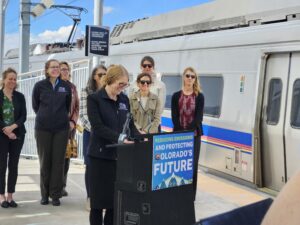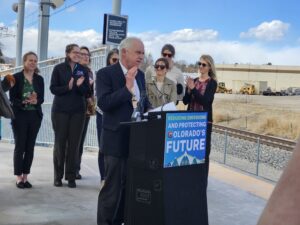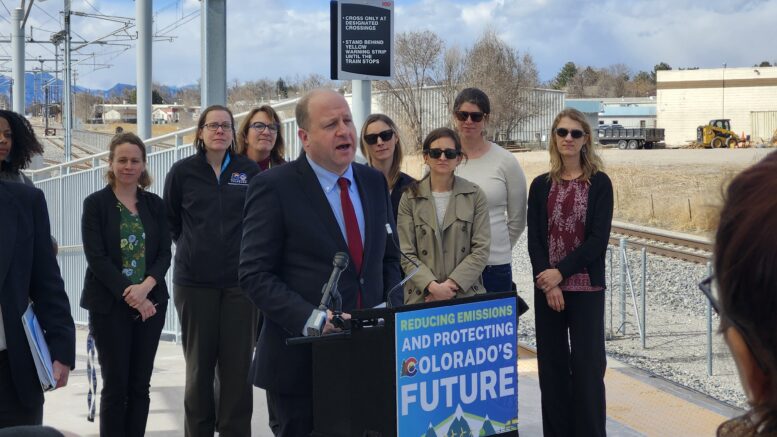Gov. Jared Polis on Monday unveiled an updated version of Colorado’s three-year-old Greenhouse Gas Pollution Reduction Roadmap, featuring 49 new short-term actions to help the state reach its ambitious goal of 50% cuts by 2030.
The actions involve more employment of land-use planning to reduce transportation-sector emissions, enactment of more clean-energy strategies such as carbon capture and a new focus on preparing the state’s distribution system to handle more electrification. But the roadmap also lays out strategies the Polis administration rejected, many in the name of affordability, and includes a long explanation of why it is opposed to phasing out all oil-and-gas drilling permits despite fellow Democrats having introduced a bill to do just that.
The updated roadmap comes just three years after the governor and multiple department leaders offered the first plan to cut emissions — and have checked off 95% of the short-term actions listed there, which have gotten Colorado 80% of the way to its 2030 goal. The next steps, Polis explained at a news conference at the Westminster Station Regional Transit Development facility, are meant to raise the bar and get across the first goal line by increasing proven strategies and using developing technology to push further.
“As Coloradans, we are so proud of our nation-leading efforts to reduce emissions. This updated roadmap aims to ensure Colorado continues to lead,” Polis said while surrounded by several of his cabinet members who were vital to the update. “Look, if this were easy, it would have been done already. But I know that Colorado’s future is bright.”
New roadmap has new focus
Under a law change in 2023, Colorado’s newest goals include a 50% emission cut (versus 2005 totals) by 2030, a 75% cut by 2040 and a net-zero emissions landscape by 2050. Polis emphasized that the state has made great strides toward its early goals by offering low- and zero-emissions opportunities, including expansion of solar and wind power, growth of electric-vehicle sales to 17% of new purchases last year and reducing emissions in the oil-and-gas sector, which already has exceeded 2030 goals according to state figures.

Colorado Department of Transportation Executive Director Shoshana Lew laughs as a train rolls by while she talks about the need for more transit options during a news conference on Monday.
Maybe the biggest new push in the “Roadmap 2.0” is the governor’s efforts to tie land-use planning to emissions reductions by emphasizing more houses and multifamily structures being built near workplaces and near transit lines. Near-term action items include expansion of transit and rail lines, more programs to increase transit ridership, the construction of more walkable neighborhoods and the completion of more streets in which multimodal options are connected.
Those goals come as the governor is pushing a package of bills this legislative session that would fund local housing-needs assessments, permit construction of accessory dwelling units on home lots and use both incentives and penalties to boost cities’ housing density allowances near transit lines. Several major components have hearings scheduled in the next two weeks.
“This puts a critical focus on land-use patterns,” Will Toor, executive director of the Colorado Energy Office, said at the news conference. “We know housing policy is climate policy, and reforming land use to let people live near where they work is key to reducing greenhouse gas emissions.”
Roadmap pushes carbon capture
Also key, according to the roadmap and state leaders, is the development of new energy sources, including carbon capture, hydrogen and geothermal energy, some of which have run into roadblocks from legislators concerned about their environmental impacts. The plan specifically calls for leading a regional strategy on direct air capture and carbon dioxide removal, as well as study of alternative uses of oil and gas wells — steps that, combined, could be achieved by permitting the capture of carbon from industrial plants that could be pumped back into the ground for storage.
Roadmap 2.0 continues to seek emissions reductions from some already-tapped targets, such as the creation of net-GHG-neutral strategies for oil-and-gas development and the authoring of a strategic plan for electrification of buildings. And Colorado Department of Transportation Executive Director Shoshana Law emphasized hopes to develop more statewide train travel, which Polis has pushed in recent years.

Colorado Energy Office Executive Director Will Toor discusses plans to lower greenhouse gas emissions during a news conference Monday at Westminster Station.
And if seeks to prepare Colorado for longer-term emissions reductions rather than just focusing on immediate cuts. The Colorado Energy Office’s three biggest priorities are at the top of the near-term actions list: updating utility clean-energy plans for 2040, modernizing and permitting siting for wind and solar projects and reforming distribution system planning so that the grid can accommodate a boost in electricity.
“The future of natural resources that we love and rely on in Colorado depends on all of us working together,” said Dan Gibbs, Colorado Department of Natural Resources executive director, at the event.
What Polis will not back
But the roadmap also lays out ideas that were suggested by Coloradans that Polis ultimately rejected, often because they could ramp up costs in ways that particularly would disadvantage low-income Coloradans. Those included establishing driving disincentives like congestion pricing or vehicle-miles-traveled fees, requiring zero-emission appliances for residential and commercial buildings and adopting a low-carbon fuel standard.
The roadmap also vehemently rejected the idea of phasing out oil-and-gas permitting or production, saying that strategy would hurt low-income consumers without meaningfully reducing emissions, as companies would just import oil and gas from other states. Instead, the governor emphasized, he will focus on deploying technologies that reduce or eliminate emissions, from electric vehicles to electric heat pumps, believing their adoption will accelerate reduction of oil-and-gas usage far faster than production restrictions.
“If (production phaseout) were implemented at a large enough scale to have a meaningful impact, it would drive up the cost of living for the many Coloradans who can’t yet afford to make the switch to cleaner alternatives,” the appendix to the report reads. “A strategy of limiting the supply of fossil fuels will harm lower-income residents and cause significant public concern. This is evident by the recurring, predictable and understandable public frustration toward high gasoline prices in the summertime when demand spikes for road travel, or the understandable frustration and hardship Coloradans face from increased gas prices in the winter to heat homes and businesses.”
